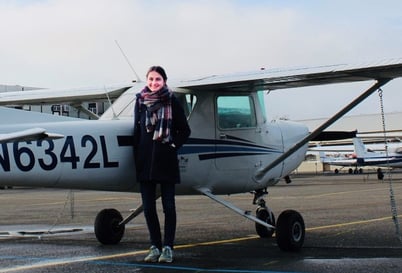I would be lying if I said that I always wanted to become a pilot or that it was my dream to fly when I was a child. Instead, I never really considered any profession in the aviation industry and went into health science instead. While working at the hospital I came in contact with some of the flying medical staff and they told me a little about their experience.

In Switzerland, we have an organization called Rega, which mostly does search and rescue with helicopters in our mountainous terrain. In addition to the helicopters, it also has a small fleet of jets that transport intensive-care patients across the world. So, I attended their orientation and quickly realized that aviation could be something for me and that I wanted to learn how to fly airplanes.
In the future I would like to be part of this organization or working for an airline company.
2. What can a potential student expect when starting school?Every start at a new place can be a little stressful at the beginning. However, the environment at the Hillsboro campus is very warm and friendly. Everybody will help you if you have a question and the Instructors make sure that you will receive the best training possible. It’s such a great community and I feel grateful that I can be a part of it!
3. What is the daily time commitment to becoming a pilot?
Generally speaking, the training at HAA is a very personal and flexible education. A lot depends upon the student and how much time he/she is willing to invest in flying and studying.
Fully focusing on flight training and not needing to worry about work will make the education easier. However, it is definitely doable to work and go through flight training simultaneously. The key is to balance studies, work and free time so that one can constantly improve his/her ground knowledge and flying skills.
4. What is your favorite part of the training at Hillsboro?
The community is definitely something special here at the Hillsboro campus. I’m privileged to be able to meet so many people of different nationalities and backgrounds. Hillsboro has students from all over the world and I feel this diversity makes the training atmosphere really special. The support you get from the flight instructors and the other students is immense. If you have a question, you can ask anyone and they will be happy to help and support you.
5. Why did you choose Hillsboro?
Basically, there were three main factors that made me choose Hillsboro Aero Academy. First off, I wanted to study at a location where people speak English because that is the language used in aviation. Second, I was looking for a flight school that can issue an F-1 Visa. The final reason was the geographical location of Hillsboro. The Pacific Northwest has great mountains and provides all kinds of different weather conditions, which is great for training purposes.
6. What are some of the biggest challenges when learning to fly?
Everyone will reach a point in their training wherein the challenges will seem a little overwhelming. For example, at the beginning, I found it really difficult to establish my personal minimums. With dynamic and complex weather situations, making go or no-go decision is tricky and I’m still in the process of learning it. I’m very lucky to have a terrific and knowledgeable CFI, who is supporting me throughout my journey. He is always giving me a heads up and I can learn a lot from his constructive debriefing and feedback.
7. What is your favorite thing about the Pacific Northwest?
The diversity of Oregon‘s landscape is breathtaking. Not only does it have beautiful forests and rivers but also mountains, where you can go skiing during the winter months and hiking in summer. When going further towards Eastern Oregon the climate changes into a desert-like landscape. In my opinion, the coast and the endless beaches are one of the highlights that Oregon has to offer. Especially, the rocks and cliffs of the nearby town of Seaside are impressive. I enjoy exploring the outdoors and it provides the perfect opportunity to relax and spend time with friends.
